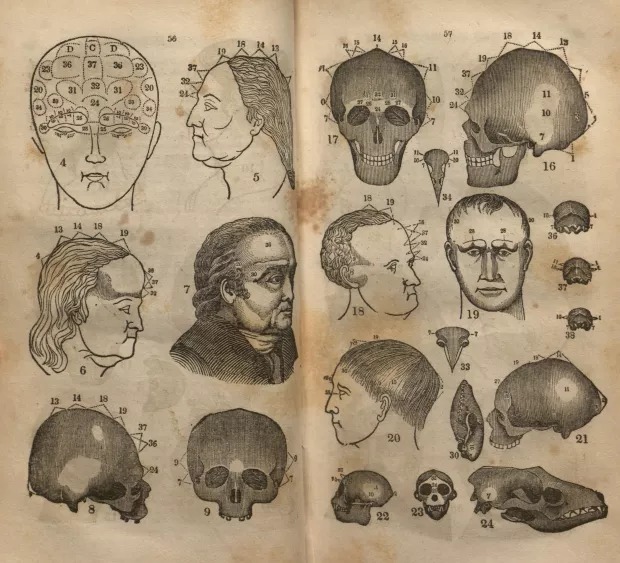Creation Date
1847
Height
15 cm
Width
19 cm
Medium
Genre
Description
This image provides multiple illustrations of skulls and famous busts, providing measurements for each by which organ size can be determined. Note especially the famous political figures, as well as the attention paid to notorious criminals. The choice of heads displayed in Fowler’s Practical Phrenology (1847) is suggestive of the larger issues towards which phrenology was applied. Note especially the famous literary figures. The illustrations invite a comparison of humans to animals as well as a comparison of classes, ethnic groups, and levels of adherence to social norms.
The mapped head was associated with phrenology from its earliest publications throughout the nineteenth century. It provided a useful map of the locations on the skull discussed in phrenological tracts. One contemporary reviewer explained, “The author’s mode of treating the subject is illustrated, and rendered very intelligible, by a plate of the human head having the organs delineated” (“The Phrenological System"). Phrenological illustrations published by Fowler and Wells and others allowed untrained Americans to conduct their own phrenological readings. Similar illustrations were available to a British audience throughout the 1800s. The choice of heads displayed here is suggestive of the larger issues toward which phrenology was applied. By choosing to include “Le Blanc, the murderer” and “Philip, a notorious thief and liar,” the illustrator and Fowler record the public’s interest in using phrenology to identify criminals—an interest further documented in news articles and phrenological tracts like The Phrenological Journal (“Further Particulars of Thurtell, &c.”; Phrenological Journal). The application of phrenology to a photographic archive of criminals is well-documented by Allen Sekula (11ff). Similarly, the inclusion of Washington and Franklin is part of a larger phrenological tradition in which key historical figures are used as types in phrenological writing: Combe, for example, compares the large “animal organs” and small “organs of the moral sentiments and intellect” of Pope Alexander VI (15th C) to the large “organs of the moral sentiments and intellect” of Philipp Melancthon (16th C). In doing so, he seeks to contrast the former’s disposition towards "animal indulgence” and tendency “to seek gratification in the directest way” with the latter’s exemplary role as a “great and virtuous reformer” (Combe 30). Finally, phrenological guides trained the nineteenth century reader in a gaze which privileged the exterior and the scientific—a gaze Michel Foucault identified as the “clinical gaze” (Foucault 103ff).
Associated Works
Copyright
Copyright 2009, Department of Special Collections, Memorial Library, University of Wisconsin-Madison, Madison, WI
Collection
Accession Number
BF 870.F6
Additional Information
Bibliography
"Advertisement 2 -- no Title." Christian Register and Boston Observer (1835-1843) May 13 1843: 76. ProQuest. Web. 1 May. 2009.
“Article VI.” American Phrenological Journal. (1841): 185-9. Print.
Colbert, Charles. A Measure of Perfection. Chapel Hill: U of North Carolina P, 1997. Print.
Combe, George. Outlines of Phrenology. 5th ed. London: Longman & Co., 1835. Print.
Dames, Nicholas. "The Clinical Novel: Phrenology and 'Villette.'" NOVEL: A Forum on Fiction29.3 (1996): 367-390. Print.
Foucault, Michel. The Birth of the Clinic. Trans. Alan Sheridan. New York: Routledge, 2003. Print.
Fowler, Orson Squire. Fowler’s Practical Phrenology: Giving a Concise Elementary View of Phrenology. New York: Fowler & Wells, 1847. Print.
“Further Particulars of Thurtell, &c.” Examiner 18 Jan. 1824: 40-41. Print.
Paley, Morton D. Portraits of Coleridge. Oxford: Oxford UP, 1999. Print.
The Phrenological Journal and Miscellany Vol. 3. (August, 1825 – October, 1826): Edinburgh, 1826. Print.
“The Phrenological System.” The Bristol Mercury 1697 (September 30, 1822). Print.
Sekula, Allen. “The Body and the Archive.” October 39 (1986): 3-64. Print.
Spencer, Frank. History of Physical Anthropology. New York: Garland Pub., 1997. Print.
Wrobel, Arthur. "Whitman and the Phrenologists: The Divine Body and the Sensuous Soul." PMLA 89.1 (1974): 17-23. Print.

